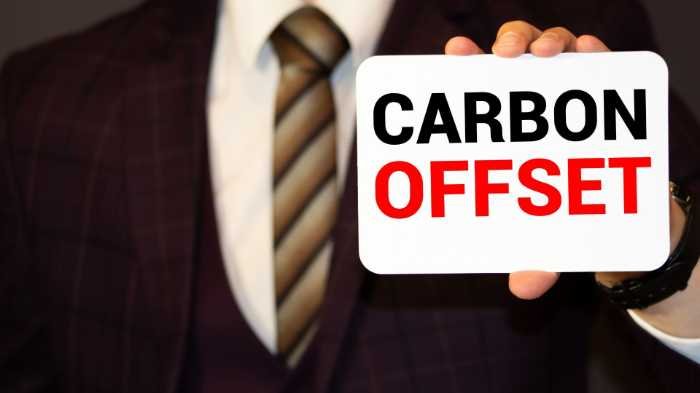Carbon credits are a way to compensate for the amount of carbon dioxide we release into the atmosphere in our daily lives. In order to create carbon credits, projects are started around the world which absorb carbon. Then businesses and organizations can invest in these projects to mitigate their own emissions while they transition to sustainable practices. These projects can include anything from capturing methane gas from landfills to upgrading equipment at factories to tree farming.
Did you know that your greenhouse gases are tallied every time you take a flight? And did you also know that there are ways to offset those emissions? In this article, we will discuss how carbon credits work and how you can buy them. Moreover, we will also explore the Canadian carbon offset program and how you can help reduce your carbon footprint.
- What are Carbon Credits?
- How do carbon credits work in Canada?
- Does Canada have a carbon offset program?
- How do I buy carbon credits?
- Who is eligible for carbon credits?
- How much do carbon offsets cost in Canada?
- Can individuals purchase carbon offsets?
- What are some of the benefits of carbon offsets?
- Cons of carbon offsets
- How can I invest in carbon offsets?
- In Conclusion
- FAQ
- How do greenhouse gas emissions affect climate change?
- What is the federal GHG offset system?
- Are fossil fuels a carbon dioxide equivalent?
- What is climate change in Canada?
- How do industrial facilities in British Columbia affect indigenous peoples?
What are Carbon Credits?
Carbon credits are known as “Offset Credits.” They are created when a company or individual invests in a project that reduces greenhouse gas emissions. The reduction can be from any sector including, but not limited to:
- Agriculture
- Forestry
- Mining
- Landfill Gas Projects
- Industrial Processes
- Commercial/Institutional Buildings
- Consumer Behaviour
The types of projects that generate offset credits can be very diverse. Some examples include:
- Capturing methane gas from landfills
- Upgrading equipment at factories
- Installing energy-efficient lighting or boilers in commercial or institutional buildings
- Replacing traditional gasoline-powered vehicles with electric or hybrid models
- Encouraging consumers to adopt more environmentally friendly behaviors, such as taking public transit, biking, or carpooling
You can find a more comprehensive list of approved offset projects on the Clean Air Foundation website.
How do carbon credits work in Canada?

Once a company has invested in a project that reduces greenhouse gas, it becomes eligible to generate offset credits. The number of credits generated will be based on the actual emissions reduction achieved by the project.
Emission credits can then be sold to other companies or organizations that want to offset their green gas pollution. The price of these credits will vary depending on several factors, such as the project’s location and the current market demand.
Does Canada have a carbon offset program?
The Canadian government has many programs to help reduce greenhouse gases. One of these programs is the Canadian Carbon Offset Program (CCOP), allowing people and businesses to buy credits to offset their carbon emissions.
The money raised from the sale of these credits will help fund green infrastructure projects. This is an excellent way for people and businesses to reduce their carbon footprint and support environmental initiatives.
Through this $2 billion project, the federal government has set a goal of reducing greenhouse gas emissions by 30 percent below 2005 levels by 2030. The Canadian Carbon Fund will play a key role in reaching this goal.
The Low Carbon Economic Fund (LCEF) was launched in June 2007, and it has helped fund a number of projects across the country. It is a voluntary program that has an extensive set of rigorous standards for offset projects. Only projects that have met these standards are eligible to generate credits.
How do I buy carbon credits?

There are a few ways to buy carbon credits. Several airline companies offer emissions trading as part of their offset programs. You can also buy credits from several websites specializing in this type of transaction. Visit any website, calculate your emissions, and purchase what you require.
When you buy credits, you invest in projects that reduce greenhouse gas emissions. These projects can include wind farms, solar arrays, and energy efficiency upgrades. By supporting these projects, you are helping to reduce Canada’s carbon footprint and fight climate change.
Who is eligible for carbon credits?
Anyone who wants to can buy renewable credits. This includes businesses, individuals, and even government organizations. The only requirement is to be registered with the Canadian Carbon Registry. Moreover, there is no maximum or minimum purchase size, so you can buy as many or as few credits as you need.
How much do carbon offsets cost in Canada?
Carbon offsets in Canada vary in price, depending on many factors. For example, the location of the project and the current market demand can affect the price. However, emission credits typically cost between $40-$50 per tonne.
Can individuals purchase carbon offsets?
Yes, individuals can purchase carbon offsets. Many airlines offer you the opportunity to purchase carbon offsets to reduce the greenhouse gas emitted from your flight. Moreover, individuals can also do emissions trading from a number of vendors who have specialized websites that operate as a carbon offset marketplace.

What are some of the benefits of carbon offsets?
There are many benefits of emissions trading:
1. Reduction of carbon footprint
One of the primary benefits of greenhouse gas offsets is that they can help reduce an individual or organization’s carbon footprint. This is because purchasing carbon offsets helps fund projects that reduce emissions, such as wind farms or energy-efficient upgrades.
2. Ability to Offset Carbon Emissions
Another benefit of buying carbon offsets is that it allows individuals and organizations to offset their carbon emissions. This means that they can essentially “neutralize” the amount of carbon dioxide they release into the atmosphere by funding projects that remove an equivalent amount of CO2 from the atmosphere.
3. Financing green infrastructure projects
Another benefit of greenhouse gas offsets is that they can help finance green infrastructure projects. These projects can include things like:
- Rainwater Harvesting
- Green Streets and Alleys
- Green Parking
- Downspout Disconnection
- Rain Gardens
- Permeable Pavements
- Planter Boxes
- Bioswales
4. Fight environment and climate change
Carbon offsets can also help fight the environment and climate change by supporting projects that reduce emissions. This is important, as climate change is one of the biggest threats to our planet.
Cons of carbon offsets
While carbon offsetting is full of benefits, there are some cons:
1. Lack of verification
One of the biggest cons of carbon offsetting is a lack of verification. This means that it can be challenging to know if the greenhouse gas offsets you purchase are doing what they’re supposed to.
2. Inaccurate measurements
Another con of carbon offsetting is that the measurements used to calculate emissions reductions can be inaccurate. This means that it’s possible for projects that claim to reduce emissions not to have a significant impact.
3. Lack of transparency
Carbon offsetting can also encounter a lack of transparency. Because of this, it can be challenging to track where your money is going when you purchase carbon offsets.
4. Sustainability
When it comes to carbon offsets, one of the biggest concerns is whether or not they are sustainable. This means that the projects that receive funding from carbon offsetting programs need to continue running to keep reducing emissions. If the projects stop running, the emissions reductions achieved by the carbon offset program will also halt.
How can I invest in carbon offsets?

The simplest way to invest in emissions trading is through carbon ETFs. These funds track an index of emissions trading and allow you to invest in a diversified portfolio of carbon credits.
Another option is to purchase carbon offsets from individual projects. These projects could be anything from renewable energy projects to forestry initiatives.
Carbon offsets are certificates representing reductions in greenhouse gas emits. When you buy a carbon offset, you’re essentially paying someone for cutting emissions on your behalf. Moreover, you can also invest in emissions trading through various online marketplaces and retailers. The current market for emissions trading is still relatively small, and the quality of offsets can vary.
Furthermore, carbon offset can be a profitable investment for anyone looking to invest in the carbon market. You can purchase offsets from an open carbon market according to the carbon pollution pricing and sell carbon credits on profit.
There are many carbon offset projects to invest in, and they offer a good return on investment. However, It’s important to do your research before purchasing carbon offsets to ensure that you’re getting good value for your money.
In Conclusion
In conclusion, carbon credits are an excellent way to invest in green technology and help reduce carbon dioxide and other greenhouse gases. There are a number of projects you can invest in, and they offer a good return on investment. However, it’s crucial to research well and choose the best carbon credit vendor.
FAQ
How do greenhouse gas emissions affect climate change?
A greenhouse gas (GHG) is a gas that traps heat in the atmosphere. The main GHGs are water vapor, carbon dioxide, methane, nitrous oxide, and ozone. Human activities like burning fossil fuels and deforestation have increased the levels of GHGs in the atmosphere, which contributes to climate change.
What is the federal GHG offset system?
The federal government announced a GHG offset system that allows organizations to compensate for their emissions by investing in emission reduction projects. The federal GHG offset system helps organizations achieve net-zero emissions.
Are fossil fuels a carbon dioxide equivalent?
Yes, burning fossil fuels is the primary source of carbon dioxide in the atmosphere.
What is climate change in Canada?
Climate change Canada is the impact of climate on the country and its people. The effects of climate change can be felt across all aspects of Canadian society, including economic, social, and environmental.
How do industrial facilities in British Columbia affect indigenous peoples?
Industries in British Columbia, Canada, include pulp mills, sawmills, and mines. These industries are significant contributors to gas emissions in the province. The government is developing protocols and final regulations are in place for a clean development mechanism. There are compliance obligations to reduce emissions that affect indigenous communities.

Dean Emerick is a curator on sustainability issues with ESG The Report, an online resource for SMEs and Investment professionals focusing on ESG principles. Their primary goal is to help middle-market companies automate Impact Reporting with ESG Software. Leveraging the power of AI, machine learning, and AWS to transition to a sustainable business model. Serving clients in the United States, Canada, UK, Europe, and the global community. If you want to get started, don’t forget to Get the Checklist! ✅
